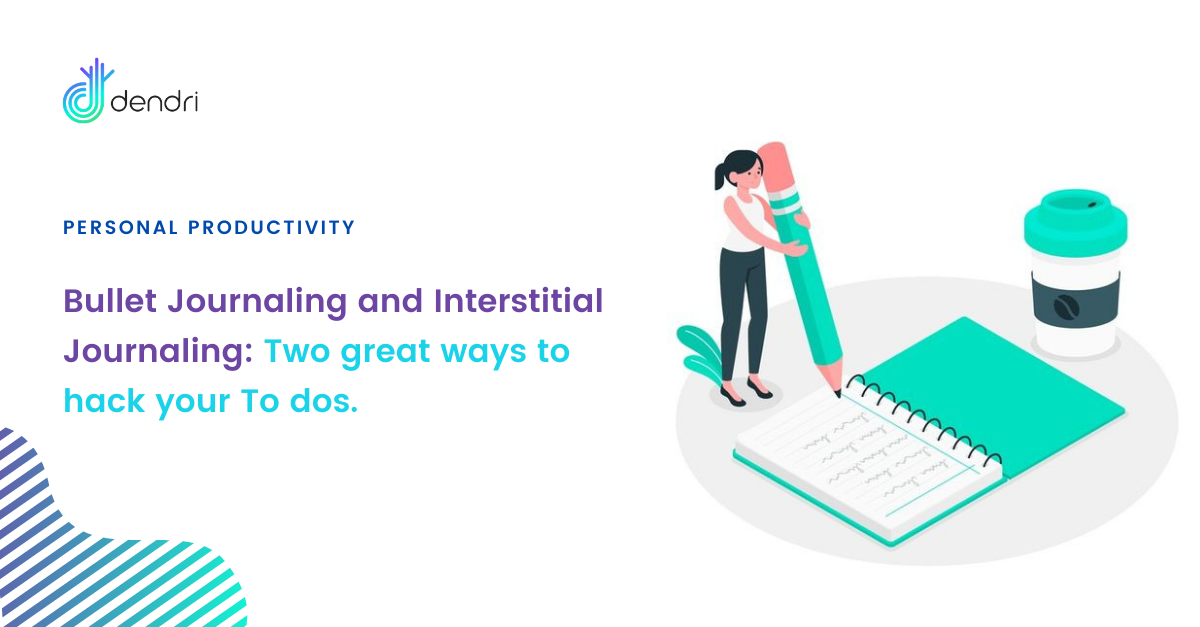
Bullet Journaling vs. Interstitial Journaling? Which One Should You Choose? Our Simple Guide to Each Breaks Them Down.

If you’re into the world of mindset, life-hacking, or productivity, no doubt, you’ve probably heard some people talking about the importance of bullet journaling or interstitial journaling.
While both are great resources for productivity, each one has particular nuances that make them better for different people. In this article, we go in-depth about the differences between these two productivity hacks and the various ways they help you organize your life.
If you’re looking for a way to be more productive in 2021, you’ll want to see what makes both of these productivity hacks have to offer.
What Is Bullet Journaling and How Does It Work?
There are two types of people in this world, there are planners, and there is the rest of the world. Let’s face it! You wouldn’t be here if you weren’t a planner.
Maybe you’re the type of person who keeps notes on your phone or has random sticky notes on your laptop. Sometimes you have so many notes, you can’t even remember where you put them all. Then, there is your calendar. It’s filled with birthdays, doctor’s appointments, and vacations (remember those).
Yes, you’re a planner at heart. But, do all those notes make you more productive? Do you know what tasks you completed last Saturday? Would you know what tasks you have coming up in the following weeks?
You would if you used a bullet journal.
Bullet Journals is the best way to take all your phone app notes, your random notes lying around your house or apartment, and all the special events from your calendar and keeping them in one, neat, organized space.
Bullet journals help you see your year at a glance. So what goes in them?
1. The Key
The first part of the bullet journal is the key. This is where you come up with a personalized system for your tasks. This video from Pick Up Limes shows a great example of how to set up your key.
She explains the key around 2:15 in the video, but honestly, the whole video is excellent for setting up a minimal bullet journal. Here’s what she uses for her key, which comes from the creator of the bullet journal.
- A simple bullet point indicates a task.
- A bullet point with an “x” indicates the task has been completed.
- An arrow to the right indicates that the task is being moved the following day.
- A dash indicates something that you need to note and is not a task.
- When you cross something out, it means it is canceled or no longer relevant.
- An asterisk or star indicates that something is important.
After you have the key, you’re ready to begin setting up your bullet journal.
2. Year At a Glance
For this section, you’ll want to split each page into three columns. At the top of each column goes a calendar for the first half of the year. You should be able to write in your calendar from January through June on two sheets.
Although this can be tedious to do, the positive here is that you only do it once in your journal, and then it’s done.
Under the calendar in each column, simply write the number of days in the month down the page. There should be enough room for you to number out the days with your bullet journal. Once you’ve completed that, put in your relevant dates for the beginning half of the year.
Now, you’ll turn the page and duplicate what you did for the second half of the year. Yes, it’s tedious, but once you’re done, you’ll love that you can see the halves of the year in one glance.
3. Month At a Glance
To set up your month at a glance takes some time at first to figure out your squares for the days, but once you figure it out, you’ll have a blueprint to follow for the following months.
You simply draw out the month of January in calendar form to help you see the month at a glance. Then once you’re done, go back to your year at a glance, add over anything important from January and add it into your box for that date.
4. Essentials
This depends on your personal preferences. This is where bullet journaling brings back some of the old journaling charm, so think about what’s important to you, and use a couple of pages to plug in some items of your own.

Some things you could add:
- Check-ins – how you’re feeling mentally, physically, spiritually, whatever.
- Brain Dump – to get out any anxiety or overstimulation.
- Habit Tracker – so you can see at a glance how you keep up with goals. Keep it simple.
- Gratitude – expressing things you’re grateful for is a powerful way to feel more positive.
Again, you can make this customizable to you. Bullet journaling is as much about mindfulness as it is about task completion.
5. Week At a Glance
The week at a glance is where you write down your whole week over two pages. Start by splitting each page into thirds. The last column can be for your weekend since fewer tasks tend to happen then. At the top, list your top three priorities first, then add bullets for any additional tasks that need to be complete.
Once you’re done, you have your framework for the weeks and months that follow. Our own Taskperiod journaling borrows from these concepts and also includes the retrospective idea of interstitial journaling, which is similar, but approaches a different goal set for your to dos.
How Is an Interstitial Journal Different?
You can think of it this way, while a bullet journal looks at your productivity on a macro scale, an interstitial journal looks at your productivity on a micro-level.
While a bullet journal focuses on the year, month, and week, the interstitial journal focuses on parts of your day.
Coach Tony, who coined the term describes the minimum journal entry as:
1. Note the time. Most people will find having these timestamps to be useful to look back on.
2. Write a few sentences about what you just worked on. “What project did I just finish? Are there any parts of that project that I’m still thinking about?” Use complete sentences rather than one word answers. “Email. Yes.” is not a valid answer.
3. Write a few sentences about what you’re about to work on. “What is the first action of the project I’m about to start? How should I approach getting the project done?”
An interstitial journal focuses on tracking time, daily tasks, and becoming more mindful throughout your daily life by using the time *between* tasks to journal about what you just did and what you’re going to do next. Some important aspects you can incorporate into the technique include:
1. Time Tracking
In an interstitial journal, time tracking is at the forefront of being productive. Tasks are broken down by time, as well as scheduling proactive breaks.
2. Tracking Tasks
This is where you put in your to-do list. They can go right into your time tracking to help you visually see your day from beginning to end. Once you complete an item, check it off.
3. Tracking Content
As you go about your day, you may become distracted. It’s only natural. If you come across interesting content, add it to your to-read list for later so you don’t get sidetracked at the moment.
4. Track Ideas
For creatives, this is a must since most ideas happen when we’re busy doing other things. Ideas could be creative or general things you’re thinking. It could even be things you’d like to do. Track them.
5. Track Wellbeing
Take inventory of how you’re feeling throughout the day. As you complete a project, reflect on how you feel, and write down the first step in your next task. Write down a few sentences about your mood or thoughts at the moment.
Really, the technique helps you empty your brain of what you just did and set you up to brainstorm how to attack what comes next. Where Bullet journaling is very prospective, intersitital journaling takes a retrospective focus, focusing on the space between tasks, and gives you spect to stop and reflect before moving on.
Which Will It Be: Micro or Macro? Bullet or Interstital?
Depending on the type of person you are and how you’d like to structure your productivity will depend on what type of journal you decide to use. If you want to manage your day, perhaps interstitial journaling is for you. If you like to plan months in advance, you’re definitely more in line with a bullet journal. Maybe, it will be a totally different way to manage your To dos. Like TaskPeriod journaling or time blocking, these are all somewhat personal techniques. The best idea is to take a read at all of them and build your own system that fits your needs.
While both are efficient practices for productivity, it’s up to the individual who uses it for how helpful it is to your overall productivity. Happy journaling!
Related Posts

Personal Kanban: The Ultimate Tool to Improve Your Legal Workflow
The ultimate step-by-step guide to getting your work out of email and into a visual system that will save you time and increase your productivity. What is a Kanban? In the early 1940s, Toyota was…
- Mar 30
- 6 mins read


How To Unknowingly Sabotage Your Law Firm Employees
As an incoming attorney, you are subject to the random discovery of pre-set workflows and tech stacks your law office has already adopted. This unilateral focus on unified workflows can do you an injustice. Explore why today.
- Mar 17
- 4 mins read
Categories
Latest Post
Friday 7/2/21 updates
- July 2, 2021
- 3 mins read
Elevate project tracking with Dendri’s new Gantt Chart
- May 8, 2021
- 3 mins read
Personal Kanban: The Ultimate Tool to Improve Your Legal Workflow
- March 30, 2021
- 6 mins read
How To Unknowingly Sabotage Your Law Firm Employees
- March 17, 2021
- 4 mins read




